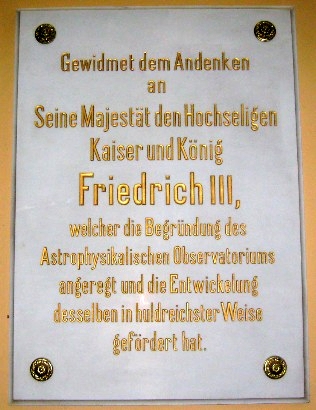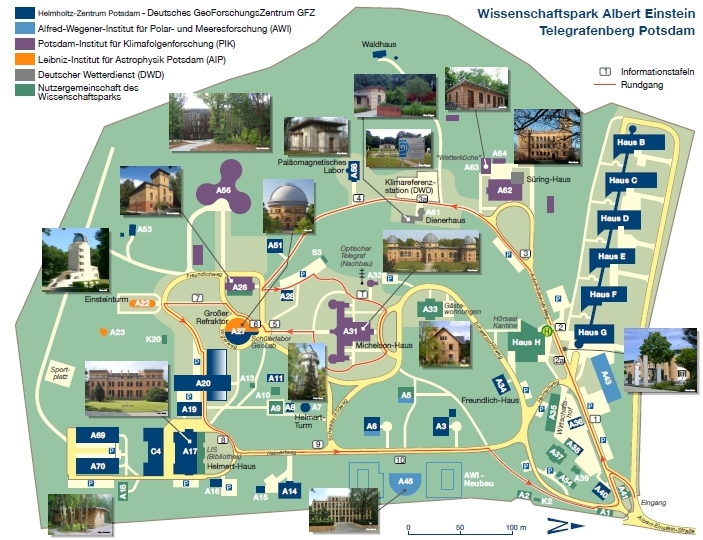History
Southeast of Potsdam's city centre, the Telegraphenberg rises to a height of 94 metres. An optical telegraph gave its name to this hill: the semaphore telegraph was erected in 1832 - a mast, 6m high, which passed on encoded information by pivoting shutters or blades. It stood on the woody hill until 1848, forming a part of the telegram chain of the Prussian state and serving to convey military information from Berlin to Koblenz.
Friedrich Wilhelm III had this chain constructed in order to exchange messages between Prussia and Rhineland at a minimum time. The chain is nearly 600 km long, the fourth telegraph out of 61 in this line stood on Telegraphenberg hill. In 1852, subsequent to the launch of the electrical telegraph, the semaphore telegraph chain was suspended.
From the 1870s on, the present-day Science Park “Albert Einstein” started to grow up on the hill.

The Astrophysical Observatory was founded in 1874. A place was sought which should be near the Berlin university and free of ground motion, a place which would not be covered with buildings within the next decades, and where the air was so clean that it would be suitable for astronomical observations. So the Telegraphenberg found its new purpose.
After developing the ground, the Royal Observatories for Astrophysics (1879, now Michelson House), Meteorology (1890, now Süring House), and Geodesy (1892, now Helmert House) were constructed. The Large Refractor - the main telescope of the Astrophysical Observatory - was brought into service in 1899. The Einstein Tower was built from 1919 to 1924.
The Potsdam ensemble was unique in terms of diversity and character. Similar facilities of a larger size could be found only outside Europe.
The brick edifices are influenced by the architectural style of Karl Friedrich Schinkel. With the exception of the Einstein Tower, they were all constructed by the architect and head construction director Paul Emanuel Spieker in the classicistic style of Mark Brandenburg’s brick Gothic.
The spacious, unconstrained park in the style of an English landscaped garden is a plan of the architect as well. The arcadian character of the park with its pleasant atmosphere was mainly meant to serve to greater air quietness.
Outstanding scientists, such as Michelson, Schwarzschild, Süring, Freundlich, Helmholtz, and many others researched on the Telegraphenberg in their day.
During the Second World War, a number of buildings on the site were heavily damaged (such as the Einstein Tower, Süring House, Large Refractor).
In 1964, the first building of the Alfred Wegener Institute was constructed. The buildings of the German Research Center for Geosciences and the new building of the Alfred Wegener Institute were constructed after 1993. From 2001 to 2007, the historical edifices on the hill were thoroughly renovated and reinaugurated.
From its origin in the end of the 19th century, the Science Park is the domicile of a number of scientific institutes with a worldwide reputation. The Telegraphenberg is now the home of the German Research Center for Geosciences / GeoForschungsZentrum (GFZ), the Potsdam Institute for Climate Impact Research / Potsdam-Institut für Klimafolgenforschung (PIK), the Long Term Meteorological Station Potsdam / Säkularstation Potsdam des Deutschen Wetterdienstes (DWD), the Research Unit Potsdam of the Alfred Wegener Institute / Forschungsstelle Potsdam des Alfred-Wegener-Instituts (AWI), and the Astrophysical Institute / Astrophysikalisches Institut Potsdam (AIP).
The name Science Park “Albert Einstein” was coined about 1992. The park and its historical edifices are protected as historical monuments.
Campus Map
Please click on the map:

Map of Telegraphenberg as PDF (442 MB) Download
Round Tour






